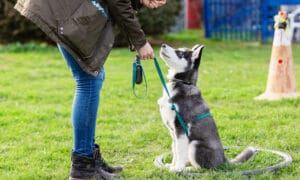“This post contains affiliate links, and I will be compensated if you make a purchase after clicking on my links.”
What is a clicker anyway? The clicker is a tool like any other training tool, except that it’s magical. To be effective with it, you have to learn how to use it well. The three essential concepts to understand in clicker training are timing, criteria and rate of reinforcement. If you have any problems in your training, it can be traced back to problems in one of these areas.
The basics behind clicker training are rather simple. The dog does a behavior, you check mark it with the clicker, and then you reinforce the behavior with a food reinforcement. Behavior that is reinforced tends to increase, so you will see more of that behavior. It’s that simple. What is reinforcement? Reinforcement is something the dog will work for. Food is easy to dispense, takes little time to consume and is something most dogs want.
- Food is a primary reinforcer (for all species), and food is something the dog inherently values and desires and will work to get or keep. Other reinforcements are water, freedom, play, sleep and touch, and will vary from dog to dog. The only thing that matters is whether your dog will work for what you’re offering.
- The clicker is a secondary reinforcer, also knows as a conditioned reinforcement or a bridge or marker. And it gains value by being associated with a primary reinforcement. When you click and then treat, you are “conditioning” the click to be a secondary reinforcer. The secondary reinforcement allows you to give your dog precise information about his behavior even when you are at a distance from your dog.
Timing
A mis-timed click can mark a behavior entirely different from what you wanted, so timing is critical. The better you are with timing, the easier and quicker it will be for your dog to learn. Click only for what it is you want.
Rate (and place) of reinforcement
While you are teaching a new behavior, every correct response (that is, every behavior meeting your criteria will receive a click and reinforcement. When training a behavior your rate of reinforcement has to be high. (Meaning how many rewards the dog gets in a given time frame).
Figuring things out is hard work for your dog, so you have to make it worth your dog’s effort.
Criteria
You can’t train if you don’t know what you want. Some behaviors are easy, just click and treat the complete behavior (a Sit). Complex behaviors will need to be broken down into small steps that look increasingly like the end behavior, known as (shaping behavior). Being able to work in small steps is the great advantage of clicker training; most people just starting out will require help to break down behaviors in achievable steps and then deciding as to when to move to the next step.
Warning; Trying to take big steps too quickly (lumping) will result in failure. And staying too long at the same criteria or step can convince your dog it’s the final behavior and make it difficult to move on to the next step. So if you don’t evaluate and make changes as you proceed, you can stall training and confuse the dog.


















